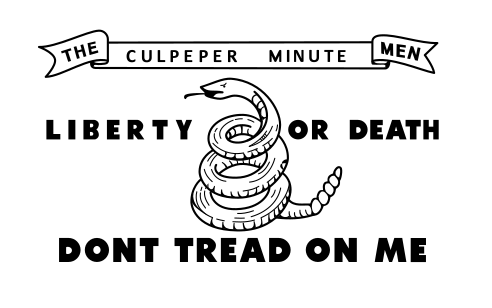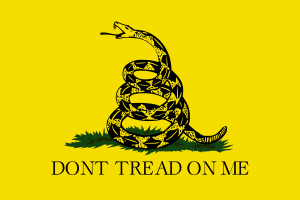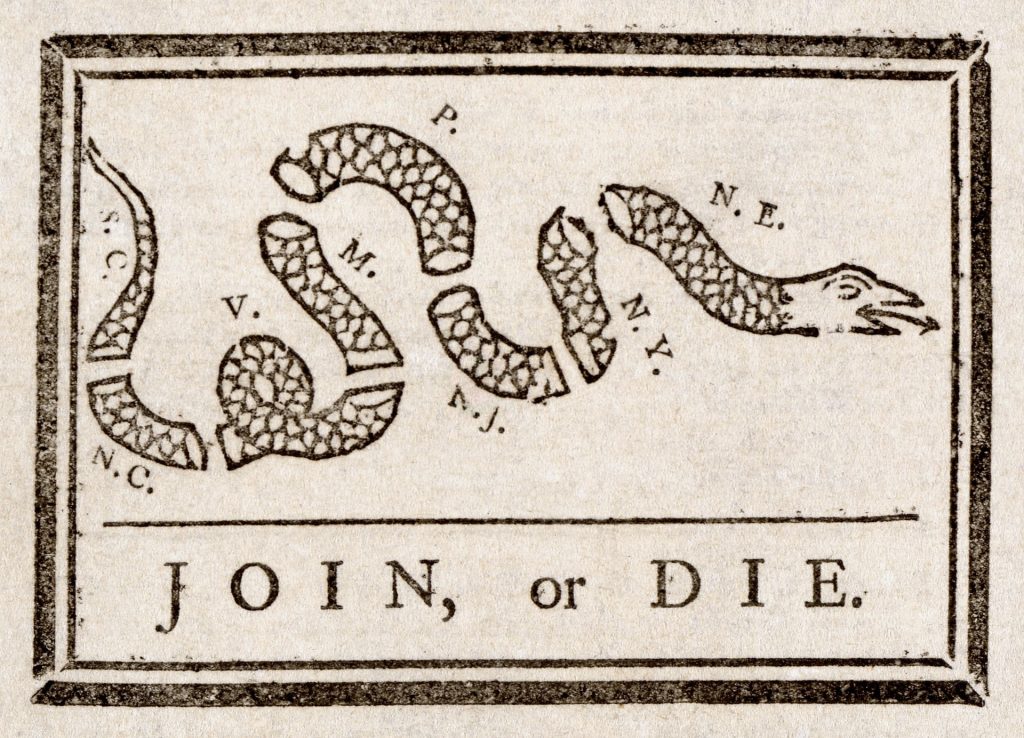Contents

Contents
The Culpeper Flag was flown by the Culpeper Minutemen of Culpeper, Virginia from 1775 until the unit was disbanded in 1776.
Originating from South Carolina and Virginia, the flag draws inspiration from two key figures of the American Revolution: Benjamin Franklin, and Patrick Henry.
Design and origin
The Culpeper Flag is white, with a 2:3 ratio, and features a coiled rattlesnake as its central symbol. There are three lines of text on the flag:
- THE CULPEPER MINUTE MEN
- LIBERTY OR DEATH
- DONT TREAD ON ME
The Culpeper Flag is a modified version of the Gadsden Flag, also known as the Hopkins flag, created by Christopher Gadsten, a politician from South Carolina, for use on the USS Alfred, a Continental merchant ship, in early 1775.

Rattlesnake imagery
The rattlesnake imagery is a reference to Benjamin Franklin’s response to the British practice of sending their prisoners to the American colonies.
In 1754, Franklin published an article in the Pennsylvania Gazette criticizing the practice, and suggesting that in exchange for the convicts, the colonists return the favor by sending rattlesnakes to Britain.
Accompanying the article, Franklin published an iconic political cartoon called Join, or Die, which showed a rattlesnake cut into eight pieces, to represent the American colonies (some of the Thirteen Colonies were grouped together, and Georgia was omitted because it was considered insignificant at the time).

After the publication of the cartoon, the rattlesnake became a symbol of unity and resistance in the colonies.
It is depicted on the flag coiled, and ready to strike. Apart from its history in Franklin’s political cartoon, the snake symbolizes resistance against British tyranny in that rattlesnakes only strike in self-defense – not to mention they are a creature only found in America.
Don’t tread on me
The slogan “Don’t tread on me” is first known to have been used on the Gadsten Flag, however it was likely used as a motto by colonists in previous years as well.
It originates from the Latin phrase “noli me tangere” (“touch me not”) which features in the Gospel of John (John 20:17).
Its meaning was more literal for the colonists: the slogan called for an end to British tyranny.
Liberty or death
“Liberty or Death” is a quote from Patrick Henry’s “Give me Liberty or give me death!” speech at the Second Virginia Convention on March 23, 1775.
The speech marked a turning point in colonial response to Crown overreach. Military conflict seemed likely, and the convention delegates were debating the best course of action. Henry was vehement that now was the time to fight for their freedom, and his arguments won the day.
Henry later became senior colonel of the Culpeper Minutemen, leading them to adopt his famous words on their flag.
Usage
The Culpeper Flag is one of the very few Revolutionary War flags that we know specific examples of how and where it was used, according to eyewitness accounts.
Although the Culpeper Minutemen did not form until July 1775, Henry first led an unofficial militia under this flag on May 2, 1775, when he marched to Williamsburg in the famous Gunpower Incident.
About two weeks prior, British Governor Dunmore seized gunpowder from the public magazine, which caused a huge amount of public unrest. Henry gathered his troops and marched on Williamsburg, under the Culpeper Flag, fully expecting to go to war – the Battle of Lexington and Concord had just occurred, and Henry thought that this was an opportunity to encourage public support for a fight.
However, after beginning the march, he was dissuaded after it was agreed that compensation would be paid for the gunpowder taken.
One of the Minutemen, Philip Slaughter, describes the Culpeper Flag being flown as the troops met to begin their march, evidencing that it was used before the Minutemen were officially formed.
Once the Culpeper Minutemen officially banded together, they helped successfully prevent British ships from landing at the coast of Hampton, Virginia in October 1775 by firing upon their ships, before helping colonial forces win the Battle of Great Bridge under their flag two months later.
Historical significance
Although the Gadsden Flag is more well-recognized today, due to its use in the Libertarian movement, the Culpeper Flag is still very historically significant as it is one of the only flags known to have been used by American forces during the Revolutionary War.
Although they were disbanded after just a year of fighting, the Culpeper Minutemen made significant contributions in the early stages of the war, especially at the Battle of Great Bridge.
The militia was reformed during the Civil War, and carried the same flag, before later joining the Spanish-American War, although they did not see action.

